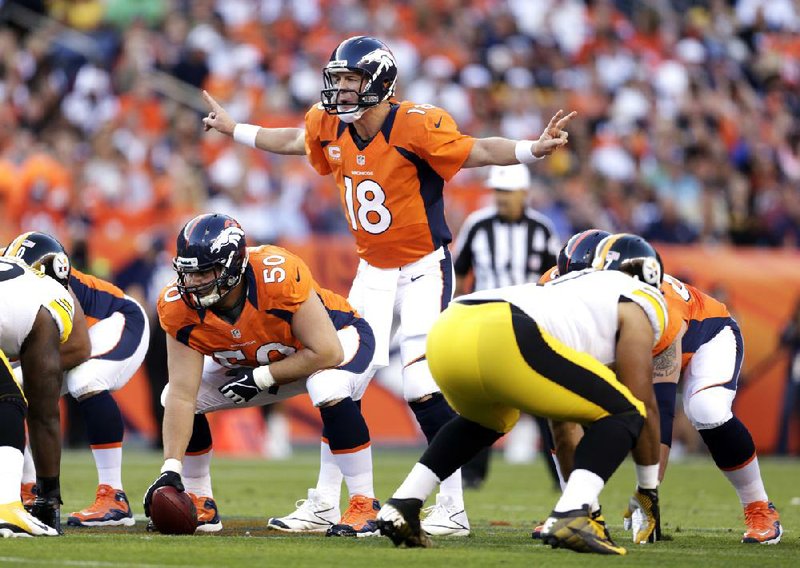DENVER — The best spies in the NFL these days aren’t behind enemy lines but on the quarterback’s own side of the ball.
Every game, two of his interior offensive linemen are miked up for network TV, bringing the sounds of the game to millions of viewers — and future opponents — who hear the signal-caller’s cadence, codes and cues, all of which are enshrouded in an increasing amount of gibberish.
Just about every quarterback is doing his best Peyton Manning imitation at the line of scrimmage these days because of increasingly complex offenses and the league’s seemingly innocuous decision to move the umpire for safety reasons in 2010.
Switching the umpire from the defensive backfield to the offensive backfield in 2010 posed a problem for the NFL: these officials wore microphones and essentially served as the networks’ on-field boom operators. That was no longer possible with the umpire stationed deep behind the quarterback instead of in front of him, so last season the league put microphones on centers and guards.
Now, everybody can listen in on everything that’s being said before the snap.
“Defensive guys appreciate that,” Denver defensive coordinator Jack Del Rio said. “You get all the quarterback’s cadence. Quarterbacks and centers don’t like it. Offensive coordinators don’t like it. By miking the center and the guards, we’re hearing the quarterback every snap. So, it’s entertaining for the fans but it’s also informative for the defenses.”
Still, before pass-happy offenses and miked-up O-linemen, it used to be a lot easier for defenders to figure out what the quarterback was up to.
“Yeah, because you’d have guys from another team that would come to your team and tell you stuff and most of it stayed true,” Broncos cornerback Champ Bailey said. “But you can’t do that anymore because every week people are changing the terms. You’ve got to be a sharp guy to play in the league these days.”
Tune into any game and you’ll see gesticulating quarterbackss using frenetic hand signals and hollering a string of phrases, much of it outright hogwash — “dummy” calls designed to trick defenses and hide the offense’s intentions. Teams change their code words week to week, even series to series.
While fans are all tuned in to this quarterback gobbledygook, many defenders are tuning it out, focusing on other signs like player movements and alignments to help them decipher play calls.
“I’m not really listening,” Ravens defensive tackle Haloti Ngata said. “I’m just focusing on what I have to do and get off on the ball.”
Sometimes, you can’t help but start to wonder, though, said his teammate, cornerback Corey Graham.
“When you’ve got guys like Peyton Manning, who’s so smart, you kind of know that he might be talking garbage so you don’t want to pay too much attention to that. But to be honest, it does catch your attention as a DB,” Graham said. “When you see a quarterback out there saying a bunch of gibberish and pointing at your receiver, you’re like, Aw shoot, what the heck is going on? I think I’m going to back up a little bit.’ It does tend to make you think that they’re up to something.”
The quarterback has been doing more talking anyway with so many teams spreading out their receivers and using the hurry-up or no-huddle offense and its check-with-me option to run or pass on just about every snap.
Linebacker Chad Greenway said that when Minnesota faced Atlanta quarterback Matt Ryan last season, “I don’t know if he had any calls in the huddle. It seemed like everything was called at the line of scrimmage, an audible or he’s checking between two and three different plays. Yeah, there’s a lot of it.”
While coaching staffs study the TV broadcasts to pick up clues about a quarterback’s calls and cadence, players find it harder to cut through the fluff and filler.
“I’m telling you, it’s tough. You can’t look into it,” Bailey said. “It’s good for people at home to see what the quarterbacks say, but anymore it’s hard to decode that.”
Younger players don’t even try.
“When it’s all said and done, they can only do two things: run or pass,” Broncos second-year safety Rahim Moore said. “They can talk as much as they want but at the same time, as a secondary, as a defense, we’re talking, too. So, when you get caught up in what they’re talking about, and vice versa, you’re forgetting about your execution.”
Sports, Pages 26 on 12/21/2012

